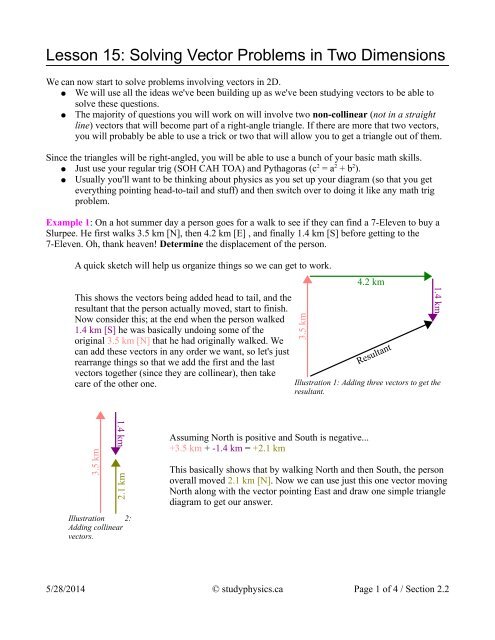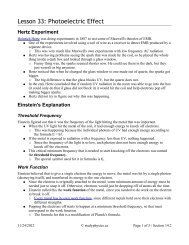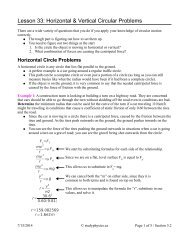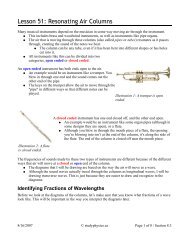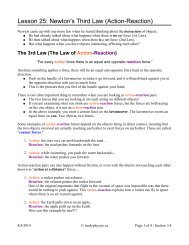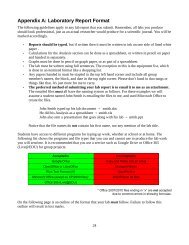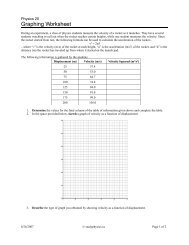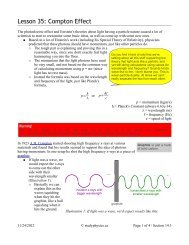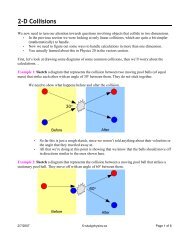Lesson 15: Solving Vector Problems in 2 Dimensions
Lesson 15: Solving Vector Problems in 2 Dimensions
Lesson 15: Solving Vector Problems in 2 Dimensions
You also want an ePaper? Increase the reach of your titles
YUMPU automatically turns print PDFs into web optimized ePapers that Google loves.
<strong>Lesson</strong> <strong>15</strong>: <strong>Solv<strong>in</strong>g</strong> <strong>Vector</strong> <strong>Problems</strong> <strong>in</strong> Two <strong>Dimensions</strong>We can now start to solve problems <strong>in</strong>volv<strong>in</strong>g vectors <strong>in</strong> 2D.● We will use all the ideas we've been build<strong>in</strong>g up as we've been study<strong>in</strong>g vectors to be able tosolve these questions.● The majority of questions you will work on will <strong>in</strong>volve two non-coll<strong>in</strong>ear (not <strong>in</strong> a straightl<strong>in</strong>e) vectors that will become part of a right-angle triangle. If there are more that two vectors,you will probably be able to use a trick or two that will allow you to get a triangle out of them.S<strong>in</strong>ce the triangles will be right-angled, you will be able to use a bunch of your basic math skills.● Just use your regular trig (SOH CAH TOA) and Pythagoras (c 2 = a 2 + b 2 ).● Usually you'll want to be th<strong>in</strong>k<strong>in</strong>g about physics as you set up your diagram (so that you geteveryth<strong>in</strong>g po<strong>in</strong>t<strong>in</strong>g head-to-tail and stuff) and then switch over to do<strong>in</strong>g it like any math trigproblem.Example 1: On a hot summer day a person goes for a walk to see if they can f<strong>in</strong>d a 7-Eleven to buy aSlurpee. He first walks 3.5 km [N], then 4.2 km [E] , and f<strong>in</strong>ally 1.4 km [S] before gett<strong>in</strong>g to the7-Eleven. Oh, thank heaven! Determ<strong>in</strong>e the displacement of the person.A quick sketch will help us organize th<strong>in</strong>gs so we can get to work.This shows the vectors be<strong>in</strong>g added head to tail, and theresultant that the person actually moved, start to f<strong>in</strong>ish.Now consider this; at the end when the person walked1.4 km [S] he was basically undo<strong>in</strong>g some of theorig<strong>in</strong>al 3.5 km [N] that he had orig<strong>in</strong>ally walked. Wecan add these vectors <strong>in</strong> any order we want, so let's justrearrange th<strong>in</strong>gs so that we add the first and the lastvectors together (s<strong>in</strong>ce they are coll<strong>in</strong>ear), then takecare of the other one.3.5 km4.2 kmResultant1.4 kmIllustration 1: Add<strong>in</strong>g three vectors to get theresultant.3.5 km1.4 km2.1 kmIllustration 2:Add<strong>in</strong>g coll<strong>in</strong>earvectors.Assum<strong>in</strong>g North is positive and South is negative...+3.5 km + -1.4 km = +2.1 kmThis basically shows that by walk<strong>in</strong>g North and then South, the personoverall moved 2.1 km [N]. Now we can use just this one vector mov<strong>in</strong>gNorth along with the vector po<strong>in</strong>t<strong>in</strong>g East and draw one simple trianglediagram to get our answer.5/28/2014 © studyphysics.ca Page 1 of 4 / Section 2.2
c 2 =a 2 + b 2c 2 =2.1 2 + 4.2 2c=4.695743c=4.7kmtanθ= oppadjtanθ= 4.22.1θ=63.43495 Oθ=63 OThe person walked a displacement of 4.7 km [N63 o E].You can also break a resultant apart to get components if you need to.● On its own this might not be very useful (like Example 2 shows).● Sometimes it can allow you to do questions that are more complex (as Example 3 shows).Example 2: A wagon is be<strong>in</strong>g pulled by a rope that makes a 25 o angle with the ground. The person ispull<strong>in</strong>g with a force of 103 N along the rope. Determ<strong>in</strong>e the horizontal and vertical components of thevector.We could just a s well be asked to f<strong>in</strong>d the x-component and y-component... it's the same th<strong>in</strong>g.It would probably be helpful to draw a quick sketch to help organize your thoughts. Then youcan start us<strong>in</strong>g trig to f<strong>in</strong>d the components.wagonIllustration 4: Pull<strong>in</strong>g a wagon with arope.We want to know the components of the 103 N vector, so we basically need to draw a triangleand then solve for the unknown sides. The triangle will be drawn us<strong>in</strong>g the force vector fromabove along with horizontal and vertical components.wagon103 N25 O103 NIllustration 5: Triangle with unknownsides.Now solve for the two unknown sides of the triangle.HorizontalVerticalcosθ= adjs<strong>in</strong> θ= opphyphypadj=cos θ(hyp)opp=s<strong>in</strong>θ(hyp)adj=cos25 O (103)opp=s<strong>in</strong>25 O (103)adj=93.3497021=93N opp=43.529681=44 NExample 3: A plane flies 34 km [N30 o W] and after a brief stopover flies 58 km [N40 o E]. Determ<strong>in</strong>e2.1 kmθ4.2 kmResultantIllustration 3: Add<strong>in</strong>g two vectors to get aresultant.25 O5/28/2014 © studyphysics.ca Page 2 of 4 / Section 2.2
the plane's displacement.Draw a very careful diagram for questions like this one. Make sure that you carefully draw <strong>in</strong>the angles and properly show the two vectors be<strong>in</strong>g added head-to-tail.40 O58kmWe can't add the vectors like this, so we need to use a way tosimplify th<strong>in</strong>gs. The easiest th<strong>in</strong>g to do is take each of thevectors <strong>in</strong>dividually and break it <strong>in</strong>to its components.3034kmOIllustration 6: Twovectors addedhead-to-tail.Once you have two x and two y components, you can addthem x to x and y to y.Then you will have one set of x and y components which canbe added to give you your resultant.34kmx30 OIllustration 7:First vectorbroken <strong>in</strong>tocomponents.yx−components<strong>in</strong>= opphypopp=s<strong>in</strong>hypopp=s<strong>in</strong>30 O 34opp=17kmy−componentcos θ= adjhypadj=cos θ(hyp)adj=cos 30 O (34)adj=29.444864kmyx40 O 58kmIllustration 8:Second vectorbroken <strong>in</strong>tocomponents.x−components<strong>in</strong>θ= opphypopp=s<strong>in</strong> θ(hyp)opp=s<strong>in</strong> 40 O (58)opp=37.2816814kmy−componentcos θ= adjhypadj=cos θ(hyp)adj=cos 40 O (58)adj=44.4305777kmNow here's the nifty part. Both of the y components are po<strong>in</strong>t<strong>in</strong>g up, so we'll call both of thempositive. When we add them we get...29.444864 km + 44.4305777 km = 73.8754417 kmThis is positive so it is also po<strong>in</strong>t<strong>in</strong>g up.The x components are a little different. The first one po<strong>in</strong>ts to the left so we will call it negative.The second x component po<strong>in</strong>t<strong>in</strong>g to the right we will call positive. This gives us...-17 km + 37.2816814 km = 20.2816814 kmThis is positive so it is po<strong>in</strong>t<strong>in</strong>g to the right.Draw a new diagram made up of just these two new vectors and f<strong>in</strong>d the resultant.5/28/2014 © studyphysics.ca Page 3 of 4 / Section 2.2
73 kmθ20 kmResultantIllustration 9: F<strong>in</strong>alresultant.c 2 =a 2 + b 2c 2 =73.8754417 2 + 20.2816814 2c=76.6089256=77kmtanθ= oppadjtanθ= 20.281681473.8754417θ=<strong>15</strong>.351686 O =<strong>15</strong> OHomeworkp82 #2p84 #1,3p88 #2The plane's displacement is 77 km [N<strong>15</strong> O E].5/28/2014 © studyphysics.ca Page 4 of 4 / Section 2.2


